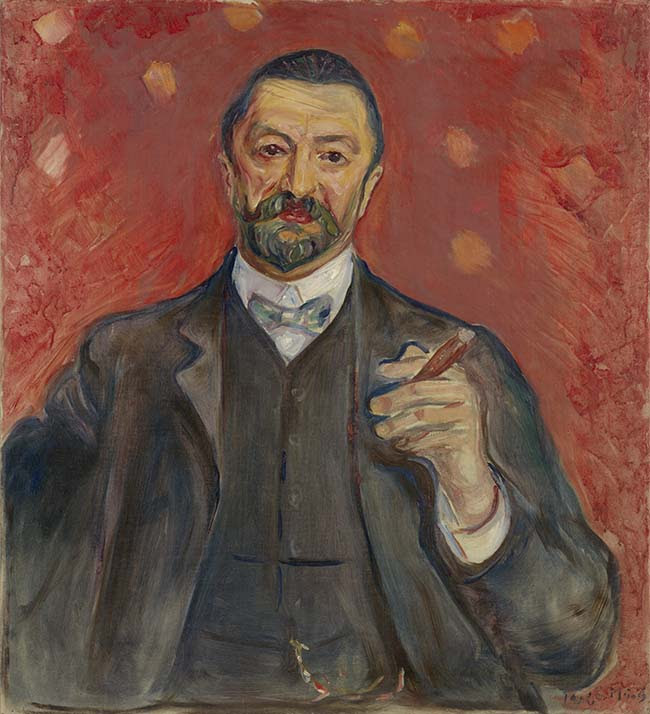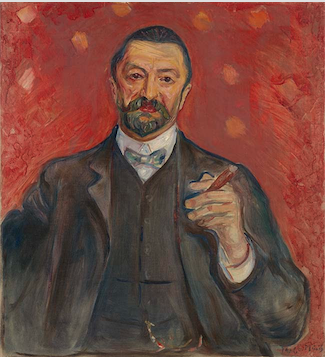
AMSTERDAM – The Van Gogh Museum has further enriched its collection with a painting by Edvard Munch. The German physicist Felix Auerbach commissioned his portrait from the Norwegian painter in 1906. The artwork goes on public display for the first time this morning, which marks the 74th anniversary of Munch’s death. The painting is the only Munch portrait in a Dutch collection and this is also the first time it has been shown in the Netherlands.
The monumental portrait, painted in expressive colors, is characteristic of Munch’s oeuvre and fits seamlessly into the Van Gogh Museum’s collection. There are striking parallels between both the work and the lives of Vincent van Gogh and Edvard Munch. ‘To be able to enrich our collection with a marvelous painting by Munch in which his affinity with Van Gogh is also clearly visible, is the fulfillment of a long-cherished dream’, museum director Axel Rüger says.

The portrait of Felix Auerbach can be seen as of today in the museum’s permanent collection on the third floor, where it features in a specially hung presentation with portraits by Van Gogh and by modern artists like Kees van Dongen and Jan Sluijters.
Felix Auerbach
Edvard Munch (1863-1944) was commissioned to paint the portrait by the sitter, the German physicist Felix Auerbach (1856–1933), who was a professor at the time at Jena University. Auerbach belonged to the cultural elite and, together with his wife Anna, had a strong interest in art. The couple visited the Nietzsche archives in 1905, where they saw the portrait of the philosopher on which Munch was working. They were deeply impressed and invited the painter to Jena shortly afterwards. Munch painted Auerbach’s portrait in February 1906 for the sum of 500 marks.
The portrait is highly characteristic of Edvard Munch’s oeuvre and also typical of this work in the period in question. The painting of Felix Auerbach is viewed as one of his finest portraits from the first decade of the 20th century. Munch presents the physicist with considerable bravura and conviction as an assertive man of the world, who gazes self-assuredly at the viewer.
Munch and van Gogh
Vincent van Gogh and Edvard Munch are often mentioned in the same breath, even though the two artists probably never met. Munch was a deep admirer of Van Gogh, whose work he discovered around 1890. Like his Dutch counterpart, he was committed to the modernization of art. Both men developed an expressive and colorful visual language to express the universal emotions of human existence, with Munch experimenting in unconventional ways with his materials and technique. The exhibition Munch : Van Gogh was held at the Van Gogh Museum in 2015, in which the parallels between the two artists were clear for all to see.
The affinities between the two painters are powerfully and persuasively apparent in their portraits in particular. The expressive use of color, for instance, is clearly visible in Felix Auerbach. Munch chose to present the sitter against an undefinable orange-red background – an approach of which Van Gogh too frequently made use.
The many artistic and personal similarities between Van Gogh and Munch make the portrait of Felix Auerbach a fantastic addition to the Van Gogh Museum’s collection.
Special presentation
The portrait, still in its original frame, is being shown in the Netherlands for the first time. What’s more, the monumental, expressive and characteristic likeness of Felix Auerbach is the only Munch portrait in the country. Up to now, the Norwegian’s only other painting in a Dutch collection was a figure piece dating from 1905 at Museum Boijmans van Beuningen in Rotterdam. The Van Gogh Museum also has the privately-owned painting Fertility (1899–1900) on long-term loan.
Felix Auerbach can be seen as of today in a specially hung presentation on the third floor of the Van Gogh Museum ’s permanent collection. In this section, the museum highlights the influence that Vincent van Gogh had on his contemporaries and the first generation of artists to follow him. The presentation juxtaposes the portrait with paintings that are related in their use of color, theme and composition, such as Van Gogh’s Zouave (1888) and monumental portraits by other artists who sought inspiration in his work, including The Blue Dress (1911) by Kees van Dongen and Salomon Beffie (1912) by Jan Sluijters. The portrait Felix Auerbach will be on permanent display.
This important work has been purchased with the generous support of the participants in the BankGiro Loterij, the Rembrandt Association (thanks in part to its Maljers-de Jongh Fund), the Prince Bernhard Cultural Fund, the VSB Fund and the members of The Yellow House (the museum’s benefactors).



